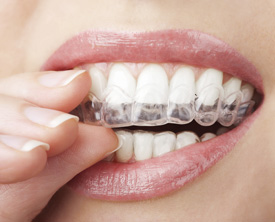Teeth Straightening
Individual Orthodontics
Discover a More Confident You!
For most people, the main reason for getting braces is to achieve a straighter, healthier smile. If you don’t feel positive about your smile, your Wallan Dentist may be able to help.
Any Age Is the Right Age!
 Braces slowly guide teeth to the desired position by applying gentle, continuous force. Braces can be made of metal, ceramic or plastic. Braces used these days are designed to move teeth with minimum discomfort. In addition to braces, other special orthodontic appliances can also be used to achieve the perfect result.
Braces slowly guide teeth to the desired position by applying gentle, continuous force. Braces can be made of metal, ceramic or plastic. Braces used these days are designed to move teeth with minimum discomfort. In addition to braces, other special orthodontic appliances can also be used to achieve the perfect result.
Braces treatment can take anywhere from one to three years depending upon the complexity of your case.
The most important factor in achieving faster, better results is cooperation of the patient. Faster results will be achieved if you are more involved with the treatment.
We use customised wires and braces, unique to every individual, also known as an individual orthodontic system. Contact us for more information!
The Phases of Treatment
A two-phase treatment approach is adopted to correct dental and facial problems early on so that more invasive procedures can be avoided in the future. In a few cases, putting off early treatment may require surgery for full correction.
Phase 1
The goal of phase one treatment is to help the jaw develop in a way that will accommodate all of the permanent teeth and improve the bite. Children often exhibit early signs of jaw problems as they grow and develop. An upper jaw that is growing too much or is too narrow can be recognised at an early age. These jaw discrepancies can be fixed early and a more stable result is achieved instead of fixing it at a later stage.
Resting Period
During this break, no active orthodontic treatment is done. Primary teeth are allowed to exfoliate naturally and permanent teeth are able to erupt. Careful supervision is done as sometimes a delay in losing primary teeth can impact the permanent teeth. Periodic recall appointments are important during this phase, usually on a six-month basis.
Phase 2
Full upper and lower braces are done during this phase. Every tooth is moved into harmony with other teeth and oral structures like lips, tongue and cheeks to attain the most comfortable and aesthetic result.
Children’s Braces

Your child’s first check-up for braces should be at around seven years old.
While there is no exact age for children to have braces, we recommend a visit at around age seven to see if braces are appropriate for your child. By this age, most kids have both baby and permanent teeth and early intervention is possible to avoid possible problems later on.
Early treatment now will give your child a healthy, beautiful smile for the future.
- Get maximum growth out of the jaws to fix the discrepancy without surgery.
- Correct the widths of upper and lower arches.
- Make space for crowded dentition.
- Correct the habits like thumb sucking, tongue thrust and help to correct minor speech problems.
- Can prevent the need for future tooth extractions.
Signs Your Child Could Use Braces
- Early or late loss of baby teeth
- Mouth breathing
- Finger or thumb sucking
- Crowded, misplaced or blocked teeth
- Jaws that pop or make sounds when opening and closing
- A hard time chewing or biting food
- Teeth that come together abnormally or do not come together at all
- Jaws and teeth that are not proportionate to the rest of the face
- Crowded front teeth around age seven or eight
Braces for Adults

You are never too old to start enjoying the health benefits of straighter teeth!
Orthodontic treatment is no longer just for teens! Many adults are undergoing orthodontic treatment to achieve nicely aligned teeth and a more confident appearance. Adults everywhere are taking advantage of orthodontic care and now you can too!
Common Reasons Adults Get Braces
- A bad bite or malocclusion, causing teeth to fit together incorrectly
- Teeth are crowded or spaced apart, possibly causing tooth decay or gum disease
- Abnormal jaw pain, or pressure that is caused by crooked teeth
- Desire for a healthier mouth and more confident smile
Retainer Instructions
Retention through proper retainer use is a very important phase of treatment. Lifelong retainer wear is required to maintain straight teeth and that beautiful smile. Below are some important tips to care for your retainers so you can maintain that beautiful, healthy smile.
- If you lose, break or retainers are not fitting, please contact us immediately. If teeth moved as a result of not wearing the retainers, more treatment would be done at an additional charge.
- The retainers are worn full time (day and night) for six months, except when eating. They are then worn at night only for six months. After this period, retainers are recommended to be tried every second night. If they feel tight, then wear them more often.
- Eating with retainers in can result in breakage. Drinking water is fine. Drinking acidic or sugary drinks, however, can result in decayed teeth as they will be trapped beneath the retainers.
- Cleaning your retainers with a brush can result in breakage.
- Remove your retainer while swimming.
- Keep retainers away from hot water, napkins, washing machines and hot car dashboards.
To know more about this advanced system of braces contact us today to schedule a consultation!
Any surgical or invasive procedure carries risks. Before proceeding, you should seek a second opinion from an appropriately qualified health practitioner.
Invisalign®
Straighten Your Teeth With Invisalign®
Ready to renew your smile?
Invisalign takes a modern approach to straightening teeth, using custom-made series of aligners created for you and only you. These aligners are made of smooth, almost invisible plastic that you wear over your teeth.
Wearing the aligners will gradually shift your teeth into desirable position. There are no metal braces to attach and no wires to tighten.
What Conditions Does Invisalign® Treat?
- Gapped Teeth
- Overbite
- Underbite
- Open Bite
- Crossbite
- Overly Crowded
If you have a specific dental condition you don’t see here, please call us so we can discuss if Invisalign® is right for you.
Getting Started with Invisalign®
When you come to our clinic, we’ll do an examination to understand what your objectives are in being fitted for Invisalign®.
Then, we’ll take X-rays, photographs and impressions of your teeth. All of the information we gather is submitted online directly to Invisalign®. A 3-D image of your teeth is used to create a treatment plan customized to your teeth.
![]()
The Invisalign® Plan

Say goodbye to braces and hello to Invisalign!
Based on treatment plan, custom-made clear aligners are created specifically for you and slide right over your teeth. You will need to wear these aligners all day and only remove them to eat or brush and floss your teeth.
These comfortable aligners will be changed approximately every two weeks, gradually making the changes you desire in each stage. The total number of stages will depend on the changes necessary.
Over the course of about a year, you’ll be able to enjoy your favorite foods and maintain your normal lifestyle while your teeth align perfectly.
During this process, we’ll have you stop in regularly to make sure everything is progressing well with achieving your best smile.
At Wallan Dental, we are proud to have Dr Raman Bhinder with us. She is fully trained and qualified Invisalign provider with plenty of experience in helping many individuals achieve great smile with this revolutionary way of teeth straightening.
For more info, please visit www.invisalign.com.au and contact us for a consultation!

